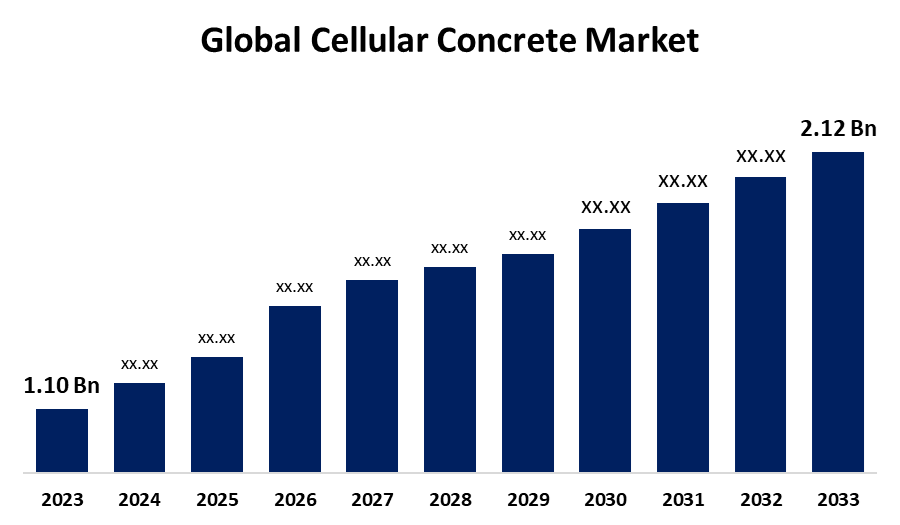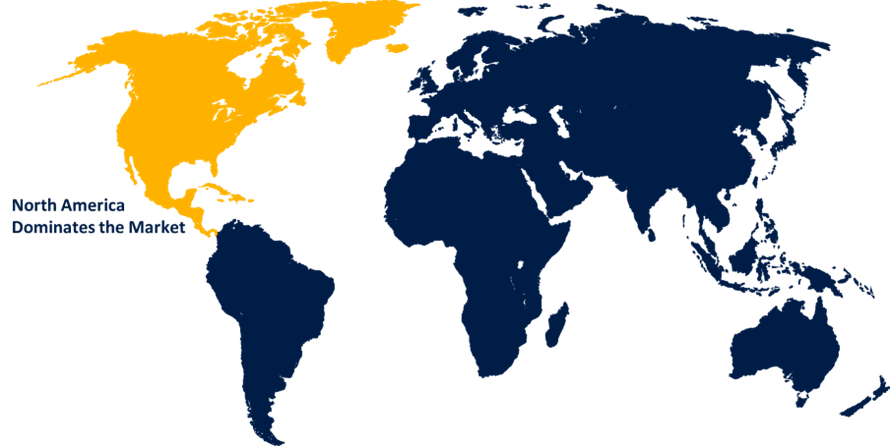Global Cellular Concrete Market Size, Share, and COVID-19 Impact Analysis, By Application (Building Material, Road Sub-Bases, Concrete Pipes, Roof Insulation, and Bridge Abutment), By End-User (Residential And Non-Residential), and By Region (North America, Europe, Asia-Pacific, Latin America, Middle East, and Africa), Analysis and Forecast 2023 - 2033
Industry: Chemicals & MaterialsGlobal Cellular Concrete Market Insights Forecasts to 2033
- The Cellular Concrete Market Size was valued at USD 1.10 Billion in 2023.
- The market is growing at a CAGR of 6.78% from 2023 to 2033.
- The Worldwide Cellular Concrete Market is expected to reach USD 2.12 Billion by 2033.
- Asia Pacific is expected to grow the fastest during the forecast period.

Get more details on this report -
The global Cellular Concrete Market Size is expected to reach USD 2.12 billion by 2033, at a CAGR of 6.78% during the forecast period 2023 to 2033.
The cellular concrete market is experiencing significant growth due to its lightweight, cost-effective, and environmentally friendly properties. Cellular concrete, also known as foam concrete, is made by incorporating foam into the mix, resulting in a material with low density and high insulation capabilities. It is used in various applications, including construction, road projects, insulation, and infrastructure development. The demand for cellular concrete is driven by its advantages over traditional concrete, such as reduced weight, better thermal performance, and ease of handling. Additionally, its sustainability benefits, such as lower carbon emissions and energy efficiency, are propelling its popularity. The market is expected to expand as more industries adopt green building materials and as urbanization continues to increase globally.
Cellular Concrete Market Value Chain Analysis
The cellular concrete market value chain involves several stages, starting with raw material procurement, including cement, water, foam agents, and additives. These materials are sourced from suppliers and transported to manufacturing plants. In the production phase, raw materials are mixed to form cellular concrete, with foam agents creating the desired air pockets. The processed concrete is then molded into blocks, panels, or other forms based on the end-use requirements. After manufacturing, the product is distributed through various channels to construction companies, contractors, and infrastructure developers. Key stakeholders in the value chain include raw material suppliers, manufacturers, distributors, and end-users. The market's growth is influenced by technological innovations, cost-efficiency, and demand from green building initiatives, driving value creation across each stage of the chain.
Global Cellular Concrete Market Report Coverage
| Report Coverage | Details |
|---|---|
| Base Year: | 2023 |
| Market Size in 2023: | USD 1.10 billion |
| Forecast Period: | 2023-2033 |
| Forecast Period CAGR 2023-2033 : | 6.78% |
| 2033 Value Projection: | USD 2.12 billion |
| Historical Data for: | 2019-2022 |
| No. of Pages: | 220 |
| Tables, Charts & Figures: | 100 |
| Segments covered: | By Application, By End-User, By Region |
| Companies covered:: | Saint Gobain (France), Xella Group (Germany), Cellucrete (U.S.), Cematrix (Canada), Litebuilt (Australia), Laston Italiana S.P.A (Italy), Cellular Concrete Technologies (U.S.), Aerix Industries (U.S.), ACICO (Kuwait), B. G. Shirke Construction Technology Pvt. Ltd (India), Broco Industries (Indonesia), Conco (U.S.), JK Lakshmi Cement Ltd (India), CellFill, LLC (U.S.), Aircrete Europe (Netherlands), and |
| Pitfalls & Challenges: | Covid-19 Empact, Challenges, Growth, Analysis |
Get more details on this report -
Cellular Concrete Market Opportunity Analysis
The cellular concrete market presents significant opportunities driven by increasing demand for sustainable and energy-efficient building materials. With the growing focus on green construction and eco-friendly solutions, cellular concrete's lightweight, thermal insulation, and fire-resistant properties make it an attractive alternative to traditional materials. The rise in infrastructure development, particularly in emerging economies, offers substantial growth potential for cellular concrete in construction and road projects. Additionally, its application in creating cost-effective insulation and void-fill solutions further expands its market potential. Technological advancements in production methods and the increasing adoption of energy-efficient building codes contribute to market growth. Moreover, urbanization, coupled with a shift towards environmentally conscious building practices, continues to drive demand for cellular concrete, presenting long-term opportunities across various sectors.
Market Dynamics
Cellular Concrete Market Dynamics
The growth of the construction sector is fueling the expansion of the market
The growth of the construction sector is significantly fueling the expansion of the cellular concrete market. As urbanization accelerates globally, the demand for sustainable, cost-effective, and lightweight building materials rises, driving the adoption of cellular concrete in various construction applications. Its properties, such as enhanced thermal insulation, fire resistance, and ease of handling, make it an ideal choice for modern construction needs. Cellular concrete is increasingly used in residential, commercial, and infrastructure projects, including road construction and building insulation. The construction industry's shift towards green building practices and energy-efficient designs further promotes the use of cellular concrete. With large-scale infrastructure projects and eco-conscious construction initiatives on the rise, the cellular concrete market is poised for continued growth and expansion in the coming years.
Restraints & Challenges
The cellular concrete market faces several challenges that could impact its growth. One key issue is the high initial cost of production, particularly when using specialized foam agents and equipment, which can deter smaller construction firms from adopting the material. Additionally, the lack of awareness and knowledge about cellular concrete’s benefits and applications in certain regions limits its widespread adoption. Quality control is another challenge, as the consistency of foam generation and material properties can vary, affecting the final product’s performance. Moreover, despite its advantages, cellular concrete's long-term durability and resistance to external factors like moisture can sometimes be a concern. Lastly, competition from traditional building materials like conventional concrete and alternative lightweight materials may hinder market expansion.
Regional Forecasts
North America Market Statistics

Get more details on this report -
North America is anticipated to dominate the Cellular Concrete Market from 2023 to 2033. As the region focuses on green building practices, cellular concrete’s lightweight, thermal insulation, and fire-resistant properties make it an attractive option for construction, infrastructure, and insulation applications. The market is further supported by urbanization and the expansion of the residential and commercial construction sectors. In particular, the U.S. and Canada are witnessing a rise in the adoption of cellular concrete for road construction, building insulation, and void filling. Despite challenges such as higher production costs, the increasing focus on energy-efficient buildings and eco-friendly materials is expected to drive the market forward in the coming years.
Asia Pacific Market Statistics
Asia Pacific is witnessing the fastest market growth between 2023 to 2033. The cellular concrete market in the Asia Pacific region is experiencing robust growth, driven by rapid urbanization, infrastructure development, and a growing focus on sustainable construction practices. The region’s booming residential and commercial construction sectors, along with large-scale infrastructure projects, provide significant opportunities for cellular concrete adoption. Additionally, government initiatives promoting green building standards and energy-efficient designs further boost market demand. However, challenges such as the high cost of production and varying quality standards remain. Despite this, the increasing emphasis on eco-friendly construction is expected to drive the market’s growth across the Asia Pacific region.
Segmentation Analysis
Insights by Application
The building material segment accounted for the largest market share over the forecast period 2023 to 2033. The building materials segment in the cellular concrete market is experiencing significant growth, driven by the increasing demand for sustainable and energy-efficient construction solutions. Cellular concrete's lightweight nature, combined with its excellent thermal insulation, fire resistance, and ease of handling, makes it a preferred choice for various building applications. It is widely used in the construction of walls, floors, roofs, and partitions, offering cost-effective alternatives to traditional concrete. The growing emphasis on eco-friendly building practices and green certifications is further propelling its adoption in residential, commercial, and industrial construction projects. Additionally, cellular concrete’s ability to enhance energy efficiency and reduce the carbon footprint of buildings aligns with global sustainability goals, driving its demand in the building materials segment. This trend is expected to continue as urbanization and construction activities expand.
Insights by End Use
The non-residential segment accounted for the largest market share over the forecast period 2023 to 2033. Cellular concrete’s lightweight nature and excellent thermal insulation properties make it a popular choice for constructing office buildings, warehouses, shopping malls, and schools. Additionally, its fire resistance and soundproofing qualities contribute to creating safer and more comfortable environments in non-residential spaces. As cities expand and the need for sustainable construction rises, developers and contractors are increasingly turning to cellular concrete for its eco-friendly advantages and long-term cost savings. The growing emphasis on green building certifications and energy-efficient infrastructure further accelerates the demand for cellular concrete in non-residential applications, positioning it as a key material for future commercial construction projects.
Recent Market Developments
- In April 2023, Sika introduced its new cellular concrete product, SikaGrout CC, designed for use in grouting applications.
Competitive Landscape
Major players in the market
- Saint Gobain (France)
- Xella Group (Germany)
- Cellucrete (U.S.)
- Cematrix (Canada)
- Litebuilt (Australia)
- Laston Italiana S.P.A (Italy)
- Cellular Concrete Technologies (U.S.)
- Aerix Industries (U.S.)
- ACICO (Kuwait)
- B. G. Shirke Construction Technology Pvt. Ltd (India)
- Broco Industries (Indonesia)
- Conco (U.S.)
- JK Lakshmi Cement Ltd (India)
- CellFill, LLC (U.S.)
- Aircrete Europe (Netherlands)
Market Segmentation
This study forecasts revenue at global, regional, and country levels from 2023 to 2033.
Cellular Concrete Market, Application Analysis
- Building Material
- Road Sub-Bases
- Concrete Pipes
- Roof Insulation
- Bridge Abutment
Cellular Concrete Market, End Use Analysis
- Residential
- Non-Residential
Cellular Concrete Market, Regional Analysis
- North America
- US
- Canada
- Mexico
- Europe
- Germany
- Uk
- France
- Italy
- Spain
- Russia
- Rest of Europe
- Asia Pacific
- China
- Japan
- India
- South Korea
- Australia
- Rest of Asia Pacific
- South America
- Brazil
- Argentina
- Rest of South America
- Middle East & Africa
- UAE
- Saudi Arabia
- Qatar
- South Africa
- Rest of the Middle East & Africa
Frequently Asked Questions (FAQ)
-
What is the market size of the Cellular Concrete Market?The global Cellular Concrete Market is expected to grow from USD 1.10 billion in 2023 to USD 2.12 billion by 2033, at a CAGR of 6.78% during the forecast period 2023-2033.
-
Who are the key market players of the Cellular Concrete Market?Some of the key market players of the market are Saint Gobain (France), Xella Group (Germany), Cellucrete (U.S.), Cematrix (Canada), Litebuilt (Australia), Laston Italiana S.P.A (Italy), Cellular Concrete Technologies (U.S.), Aerix Industries (U.S.), ACICO (Kuwait), B. G. Shirke Construction Technology Pvt. Ltd (India), Broco Industries (Indonesia), Conco (U.S.), JK Lakshmi Cement Ltd (India), CellFill, LLC (U.S.), and Aircrete Europe (Netherlands).
-
Which segment holds the largest market share?The non-residential segment holds the largest market share and is going to continue its dominance.
-
Which region dominates the Cellular Concrete Market?North America dominates the Cellular Concrete Market and has the highest market share
Need help to buy this report?